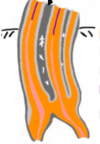Equine Dentistry Flashcards
1
Q
Anisognathism

A
- Mandibular Arcade is wider than the Mandibular Arcade
- the property of having the teeth in the two jaws unlike
- Not the teeth are wider, the GAP between them is wider
- When they chew, they consistently grind at this angle
- Get overgrowths on outside of upper arcade and inside of the lower arcade
- if they do not have sufficient power stroke from eating less fibrous foods that competition horses will eat as they need that nutrition, this can occur
2
Q
Normal Cheek Teeth Anatomy
(name all these structures)

A

3
Q
Cementum
A
Attaches to periodontal ligament
4
Q
Dentine
A
- Bulk of tooth
- tubular structure
5
Q
Enamel
A
- Hardest tissue
- Laminated Sheets
6
Q
Pulp
A
- Blood and nerve supply to tooth
7
Q
Infundibulum
A

8
Q
Cheek Teeth Anatomy
(name the structures)

A
9
Q
Gross Structure of Maxillary Tooth

A

10
Q

A
- Probing the infundibulum of the tooth
- If it goes in more than 1cm then generally we can consider we have significant infundibular caries
11
Q
Diastema
A
- A diastema (plural diastemata) is a space or gap between two teeth.
- Many species of mammals have diastemata as a normal feature, most commonlybetween the incisors and molars
- Can be a cause of overgrowths or “wave mouth” in horses
12
Q
Quidding
A
- Quidding is a response to mouth pain in which the horse loses or spits balls of semi-chewed food stuffs out of their mouth.
- The most common cause of quidding is teeth that are uneven or that have sharp points.
- This does not allow the mouth to close properly and makes chewing extremely difficult
13
Q
Shear Mouth

A
This occurs when the horse is not chewing evenly on both sides of the mouth causing uneven wear patterns in both the incisors and the cheek teeth.
The points associated with a shear mouth can be excessively sharp and cause severe damage to the delicate tissues of the cheeks and tongue
14
Q
Wave Mouth

A
- This abnormality is similar to a step mouth, but with more teeth involved.
- There are both high and low points on each arcade creating a situation where the movement of the jaw is severely inhibited in all directions causing difficulty chewing as well as difficulty with collection and performance.
15
Q
Step Mouth

A
- This occurs when one cheek tooth is either missing or is completely overpowered by the opposing cheek tooth.
- This abnormality allows the opposing or dominant tooth to grow into the gap left by the missing or weak tooth creating a situation where the lower jaw is unable to move forward or backward.
- This inability to move makes it nearly impossible for the horse to break at the poll and hence collection is unable to be achieved.
16
Q
Hook

A
- This occurs when the upper jaw is slightly forward of the lower jaw creating a situation where the first upper premolar does not meet the lower premolar and hence the front part of the tooth grows long and sharp.
- Left unattended this hook can grow into the lower jaw causing intense pain and infection. this abnormality is often seen in horses with an overbite (parrot mouth) and is sometimes accompanied by lower ramps at the back of the jaw.
17
Q
Ramp
A
- A ramp is basically the same thing as a hook, but its on the lower jaw.
- Ramps can be associated with the first lower premolar (#6) or the last lower molar (#11).
- They can cause the same complications as hooks.


